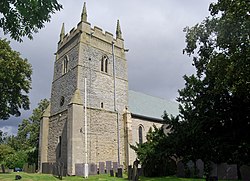Granby
| Granby | |
| Nottinghamshire | |
|---|---|
 The 12th-century All Saints Church | |
| Location | |
| Location: | 52°55’8"N, -0°53’16"W |
| Data | |
| Post town: | Nottingham |
| Postcode: | NG13 |
| Dialling code: | 01949 |
| Local Government | |
| Council: | Rushcliffe |
Granby is a small village and parish in south-eastern Nottinghamshire adjacent to the border with Leicestershire. It lies in the Vale of Belvoir.
Toponomy
The place-name Granby seems to contain an Old Norse personal name, Gráni , + bȳ (Old Norse), a farmstead, a village...so 'Grani's farm/settlement'.[1]
Population and facilities
The parish had a population 328 at the time of the 2001 census[2] and 485 (including Sutton-cum-Granby and Elton on the Hill) in the 2011 census.[3] It is situated about 14 miles east of Nottingham. Earlier census returns suggest a peak population of 439 in the 1891 census and a low point of 248 in 1951.[4] The civil and ecclesiastical parishes of Granby both include the hamlet of Sutton-cum-Granby, one mile to the north.
There is no longer a school in Granby. The old school building now serves as the village hall. Most children attend Orston Primary School, and for secondary education many go to Toot Hill School in the nearby market town of Bingham. There are bus services from Granby to Nottingham and to Melton Mowbray. The nearest railway station is at Aslockton, with trains every one or two hours to Nottingham, Grantham and beyond.
There is now only one pub in the village since the closure of the Boot & Shoe in 2015. The site has been sold for housing. The remaining pub, the Marquis of Granby (possibly the original house of that name, dating back to 1760) serves a range of real ales and has won awards for the quality of its beer.[5] The Marquess of Granby is a subsidiary title of the Duke of Rutland, used as a courtesy title by the duke's eldest son. The most famous marquess was General John Manners (1721–1770), who distinguished himself in the Seven Years' War and later entered politics.
Buildings
Parts of the parish church of All Saints date back to the 12th century. It is a Grade-I listed building, "one of the S Notts churches which were reduced in size in post-Reformation times."[6] According to the English Heritage description, it stands on a pre-Conquest site and underwent restoration about 1777 and in 1888.[7] A Roman altar stone was dug up in the churchyard in 1812.[8]
The village also has five groups of churchyard gravestones, four farmhouses, a telephone kiosk and a parish pump that are Grade-II listed features.[9] Ivy House Farm in Green Lane bears the date 1752 and Granby Farmhouse in Church St bears the date 1762. The Old Post House which was formerly the village shop and post office, was built in 1796 for Elizabeth May Hopewell, spinster of the parish. Descendants of Miss Hopewell still reside in the village. The deeds for the Old Post House refer back to a previous dwelling on the site which was built in 1580.
The Wesleyan Methodist congregation in the village is thought to have dated from 1807.[10] There was already "a place of worship for Wesleyans" in 1848.[11] However, the congregation dwindled and the chapel was converted into a private house in the early 2000s.
The advowson of Granby was held by the Duke of Rutland, but from 1917, the vicar of Granby was also the rector of St Michael and All Angels, Elton on the Hill, a village two miles to the north, and appointments thereafter were made by agreement between the two patrons. Now both churches are part of the Wiverton Group, and a Sunday service is held in them alternately.[12]
Granby of old
Granby appears in the Domesday Book of 1086 with 99 households, a large number for the period. There was already a church and two mills.[13] The lord was Robert d'Oily, who is mentioned in Domesday in connection with 127 other places, mainly in the South Midlands.[14]
Famous resident
- John Bradshaw (1812–1880), first-class cricketer and cleric, died in Granby, having been Vicar of Granby-cum-Sutton since 1845.
References
- ↑ J. Gover, A. Mawer & F. M. Stenton (eds.), Place Names of Nottinghamshire (Cambridge, 1940), p.225; A.D.Mills, Dictionary of English Place-Names (Oxford, 2002), p.154; E .Ekwall, Concise Oxford Dictionary of English Place-names (Oxford, 1960), p.202
- ↑ Office for National Statistics: Retrieved 4 June 2012.
- ↑ [1] Retrieved 3 February 2013.
- ↑ Retrieved 5 November 2010.
- ↑ [2] BBC – Nottingham 360 Images – Public Houses : The Marquis of Granby accessed 10 May 2010.
- ↑ Nikolaus Pevsner: The Buildings of England: Nottinghamshire (Harmondsworth: Penguin Books Ltd, 1951), p. 75.
- ↑ A detailed architectural description partly based on Pevsner: Retrieved 6 November 2010.
- ↑ Retrieved 30 March 2011, quoting The Nottinghamshire Village Book (Newbury, Berks: Countryside Books, 1989.). ISBN 1-85306-057-7.
- ↑ List of listed buildings: Retrieved 6 November 2010.
- ↑ Retrieved 30 March 2011.
- ↑ Samuel Lewis, ed.: A Topographical Dictionary of England, 1848, within pp. 322–5 Retrieved 5 November 2010.
- ↑ Wiverton group site: Retrieved 6 November 2010.
- ↑ Granby's Domesday entry: Retrieved 19 May 2012.
- ↑ D'Oily in Domesday: Retrieved 19 May 2012.
Outside links
| ("Wikimedia Commons" has material about Granby) |
- Parish website: Retrieved 26 July 2011.
